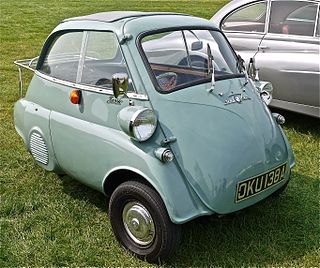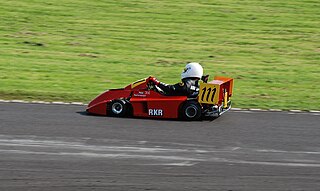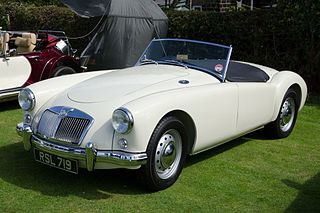
Morgan Motor Company Limited is a British motor car manufacturer owned by Italian investment group Investindustrial. It was founded in 1910 by Henry Frederick Stanley Morgan. Morgan is based in Malvern Link, an area of Malvern, and employs approximately 220 people. Morgan produce 850 cars per year, all assembled by hand. The waiting list for a car is approximately six months, but it has sometimes been as long as ten years.

The Isetta is an Italian-designed microcar built under license in a number of different countries, including Argentina, Spain, Belgium, France, Brazil, Germany, and the United Kingdom. Because of its egg shape and bubble-like windows, it became known as a bubble car, a name also given to other similar vehicles.

The Audi TT is a production front-engine, 2-door, 2+2 sports coupé and roadster, manufactured and marketed by Audi from 1998 to 2023 across three generations.

Berkeley Cars Ltd was a British car manufacturer based in Biggleswade, Bedfordshire. The company produced economical sporting microcars with motorcycle-derived engines from 322 cc to 692 cc and front wheel drive between 1956 and 1960. About 4,100 cars had been sold before bankruptcy in 1960.

The Aero was a Czechoslovak automobile company that produced a variety of models between 1929 and 1947 by a well-known aircraft and car-body company owned by Dr. Kabes in Prague-Vysocany. Now Aero Vodochody produces aircraft only.

Superkart is a form of motorsport road racing that uses karts on long circuits. The bigger difference between a superkart and most other forms of kart is that they have full aerodynamic bodykits, as well as having a longer wheel base than sprint chassis, and are generally raced on car circuits over 1,500 metres in length. The power unit, most often but not exclusively two-stroke 250 cc engines, can be specially designed kart engines or production motorcycle engines with either five- or six-speed sequential manual gearboxes. Owing to their high top speed and superb cornering ability, a superkart's aerodynamic bodywork includes a front fairing, larger sidepods, and a rear wing. They use either 130-or-150-millimetre-diameter tires and wheels and most often race on full size auto-racing circuits.

The MGB is a two-door sports car manufactured and marketed from 1962 until 1980 by the British Motor Corporation (BMC), later the Austin-Morris division of British Leyland, as a four-cylinder, soft-top sports car. It was announced and its details first published on 19 September 1962. Variants include the MGB GT three-door 2+2 coupé (1965–1980), the six-cylinder sports car and coupé MGC (1967–69), and the eight-cylinder 2+2 coupé, the MGB GT V8 (1973–76).

The MGA is a sports car that was produced by MG from 1955 until 1962.

The Messerschmitt KR200, or Kabinenroller, is a three-wheeled bubble car designed by the aircraft engineer Fritz Fend and produced in the factory of the German aircraft manufacturer Messerschmitt from 1955 until 1964.

Wiesmann GmbH is a German automobile manufacturer that specializes in hand-built custom convertibles and coupes. Brothers Martin Wiesmann and Friedhelm Wiesmann founded the company in 1988 which has its headquarters located in Dülmen. The business was temporarily closed in May 2014, and following a buyout by London-based investor Roheen Berry who took over as CEO, it is set to return with a new model, powered by a BMW M division-sourced V8 engine. The relaunch of the Wiesmann brand has more than one model, including an electric vehicle, in the pipeline and the pre-development phase of the car has been completed. A teaser video of the brand's rebirth, posted on their website, tells viewers to “expect the unexpected”.

The FMR Tg500 was a sports car built by Fahrzeug- und Maschinenbau GmbH, Regensburg (FMR) from 1958 to 1961. Based on the Messerschmitt Kabinenroller monocoque, which otherwise was a platform for three-wheelers, the Tg500 was a four-wheeled car with a two-stroke straight-two engine. FMR had taken over production of the KR200 from Messerschmitt in 1956. While the KR200 still used the Messerschmitt name and logo, the Tg500 was badged as an FMR.

The Messerschmitt KR175 microcar (1953–1955) was the first vehicle built by Messerschmitt under its 1952 agreement with Fritz Fend. In concept, although not in actual design, it was, in principle, a development of the Fend Flitzer invalid carriage. Approximately 15,000 were built before it was replaced by the Messerschmitt KR200 in 1955.

The Brütsch Mopetta is an egg-shaped, single-seat, three-wheel automobile manufactured from 1956 to 1958 with a total production of 14. It was the smallest in a series of microcars designed by Egon Brütsch.

Dante Giacosa was an Italian automobile designer and engineer responsible for a range of Italian automobile designs — and for refining the front-wheel drive layout to an industry-standard configuration. He has been called the deus ex machina of Fiat.

The Georges Irat was a French automobile manufactured by engine builder Georges Irat from 1921 to 1953.
The Rover 8 was a small single-cylinder 8 hp 1327 cc car made by the British Rover car company. It was Rover's first production car. It was remarkable for being supported by a backbone chassis rather than a conventional ladder frame. The first model was manufactured from 1904 to 1912. A Daimler-Knight sleeve valve engine option was available on the original model in 1911 and 1912.

The Mercedes-Benz 380 is an eight-cylinder powered automobile introduced by the German manufacturer Mercedes-Benz at the Berlin Motor Show in February 1933. It was withdrawn from production during 1934. Several models with similar names were produced by Mercedes-Benz during the 1930s, so that in retrospect the car is frequently identified using the manufacturer's Works Number as the W22.

The Zbrojovka Z 18 was a car produced by Československá Zbrojovka in the 1920s. Derived from the more powerful of two Z 26 designs developed following the Disk, the Z 18 was first produced in 1925. The car was produced in a variety of body types, including a four seat open-top phaeton fitted with one, two and four doors, limousine and landaulet and a two-door roadster. It had a two-stroke two-cylinder 1,004 cc (61.3 in3) engine which enabled the car to reach a speed of 80 km/h (50 mph). A total of 2,510 vehicles were produced before production ceased in 1930.
ACOMA are a French microcar maker that operated between 1972 and 1984. The cars were designed by Émile Boussereau from Villeneuve-la-Comtesse and produced in Laval from 1970 to 1972 after which manufacturing moved to Saint-Barthélemy-d'Anjou, near Angers, until production stopped in 1984.

Clúa was a Spanish motorcycle and automobile brand by Construcciones Metálicas Clúa from 1949 to 1962. The company was owned and founded by Joan Clúa i Maluquer. Its headquarters was located at 6 Avenida de Pau Casals, Barcelona, Spain, at the time called Avenida General Goded, and the assembly line was located at Carrer d'Espronceda.






















